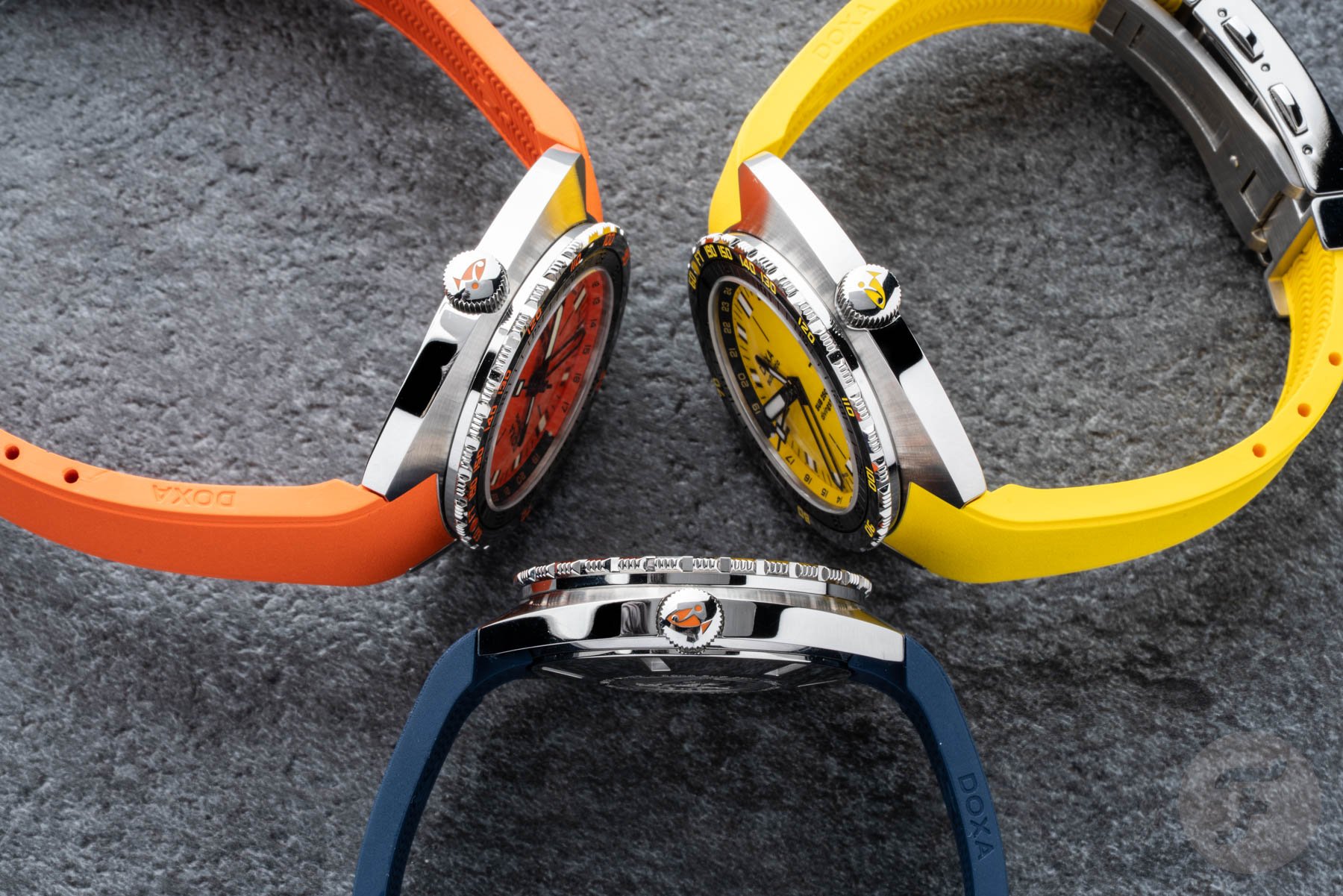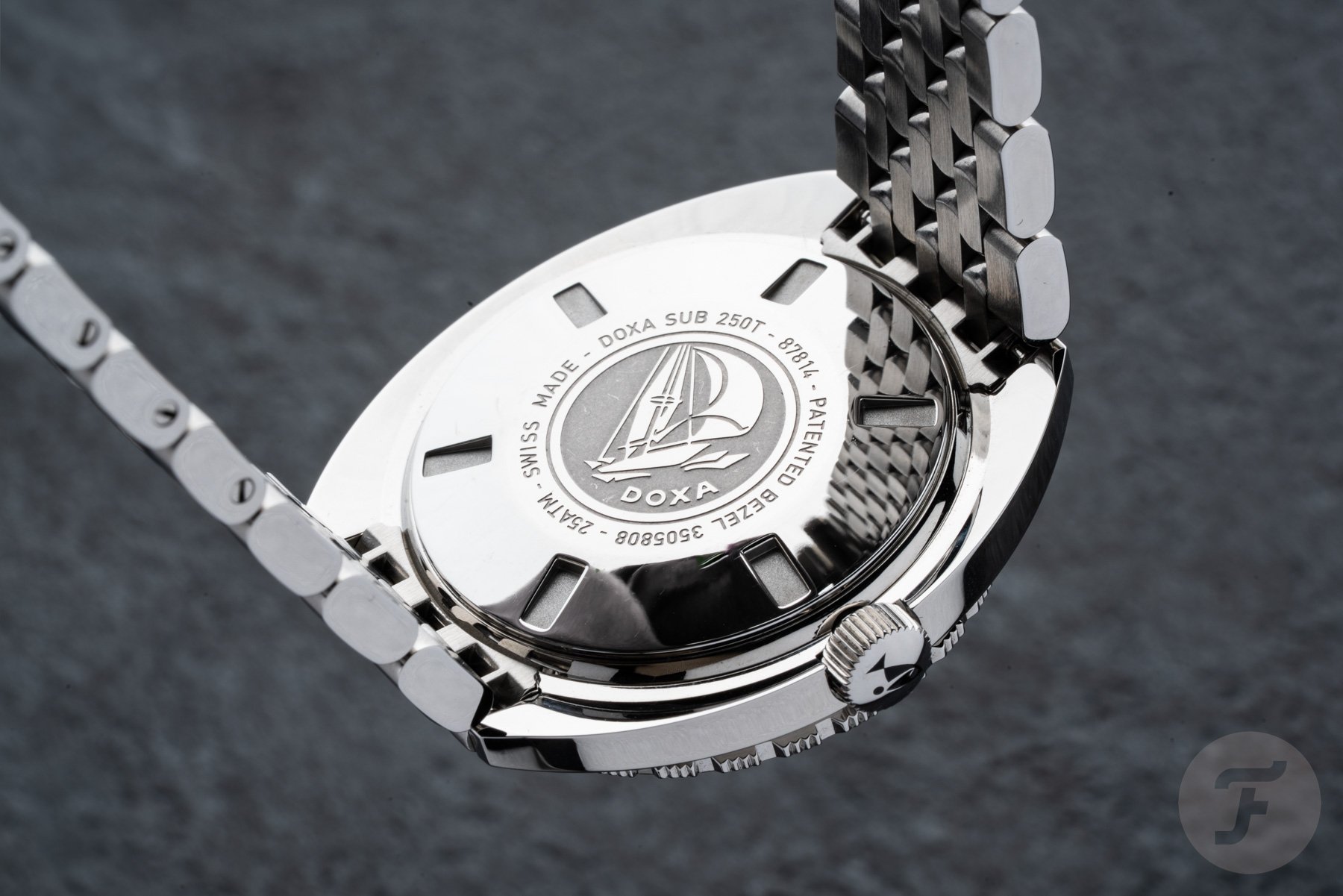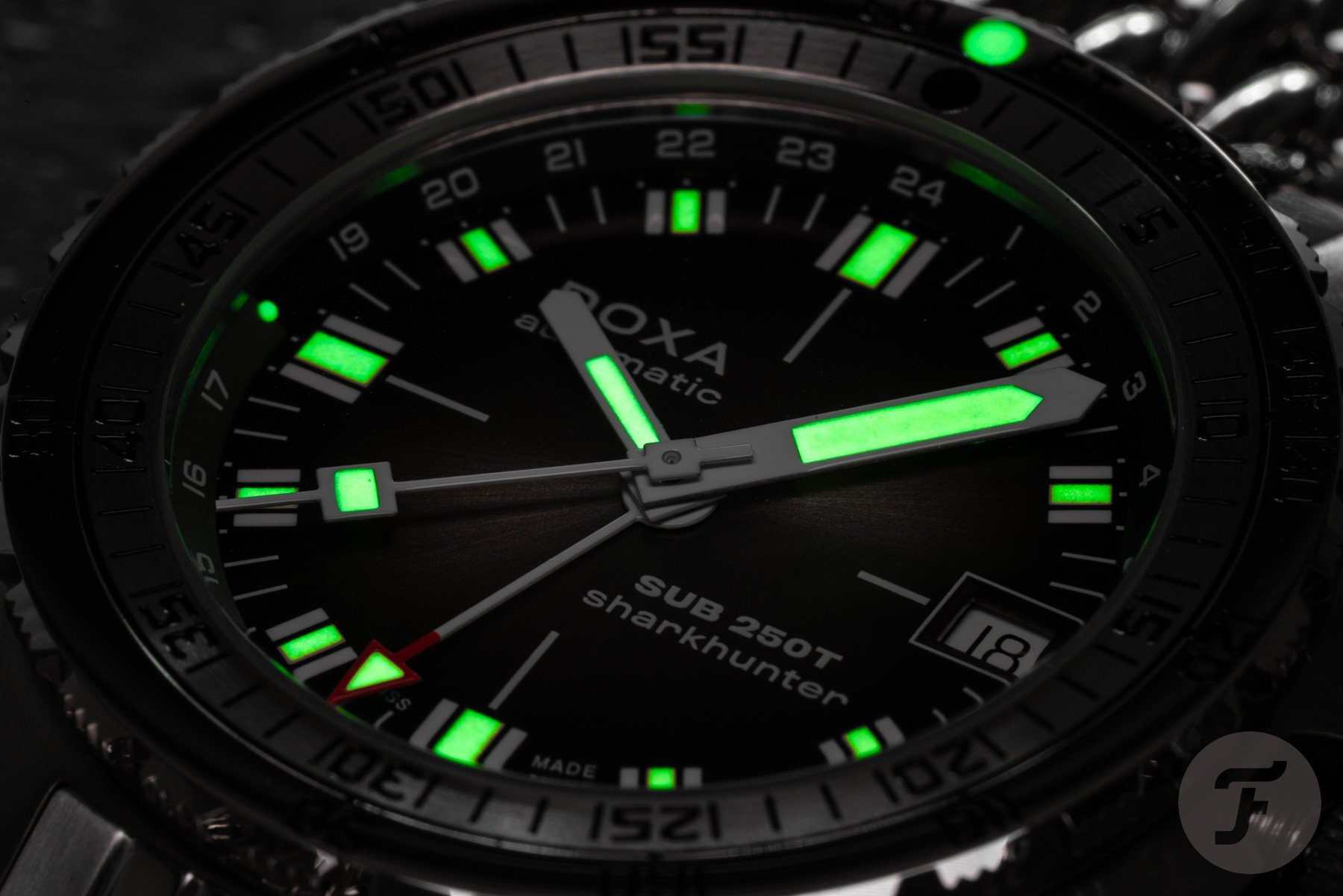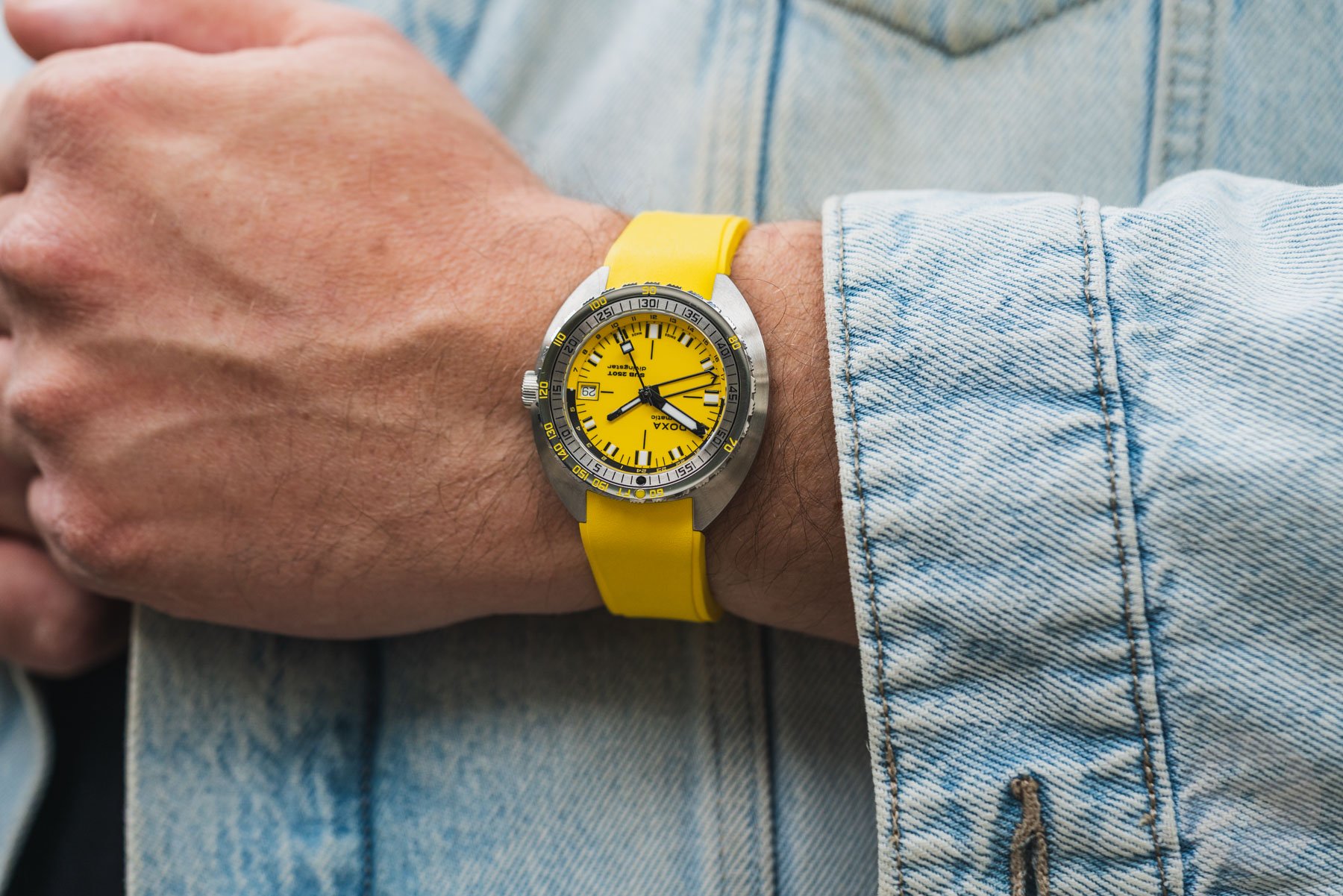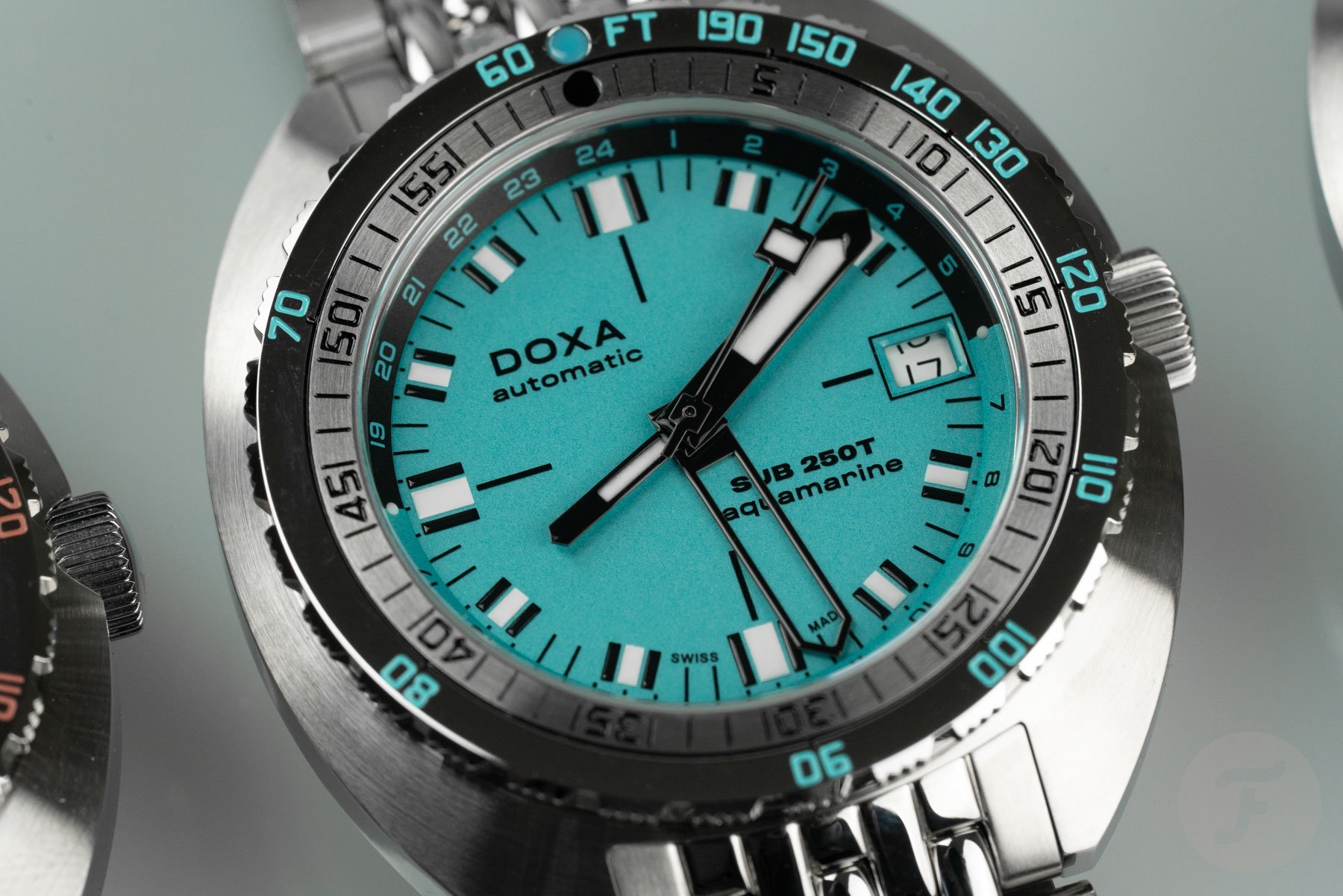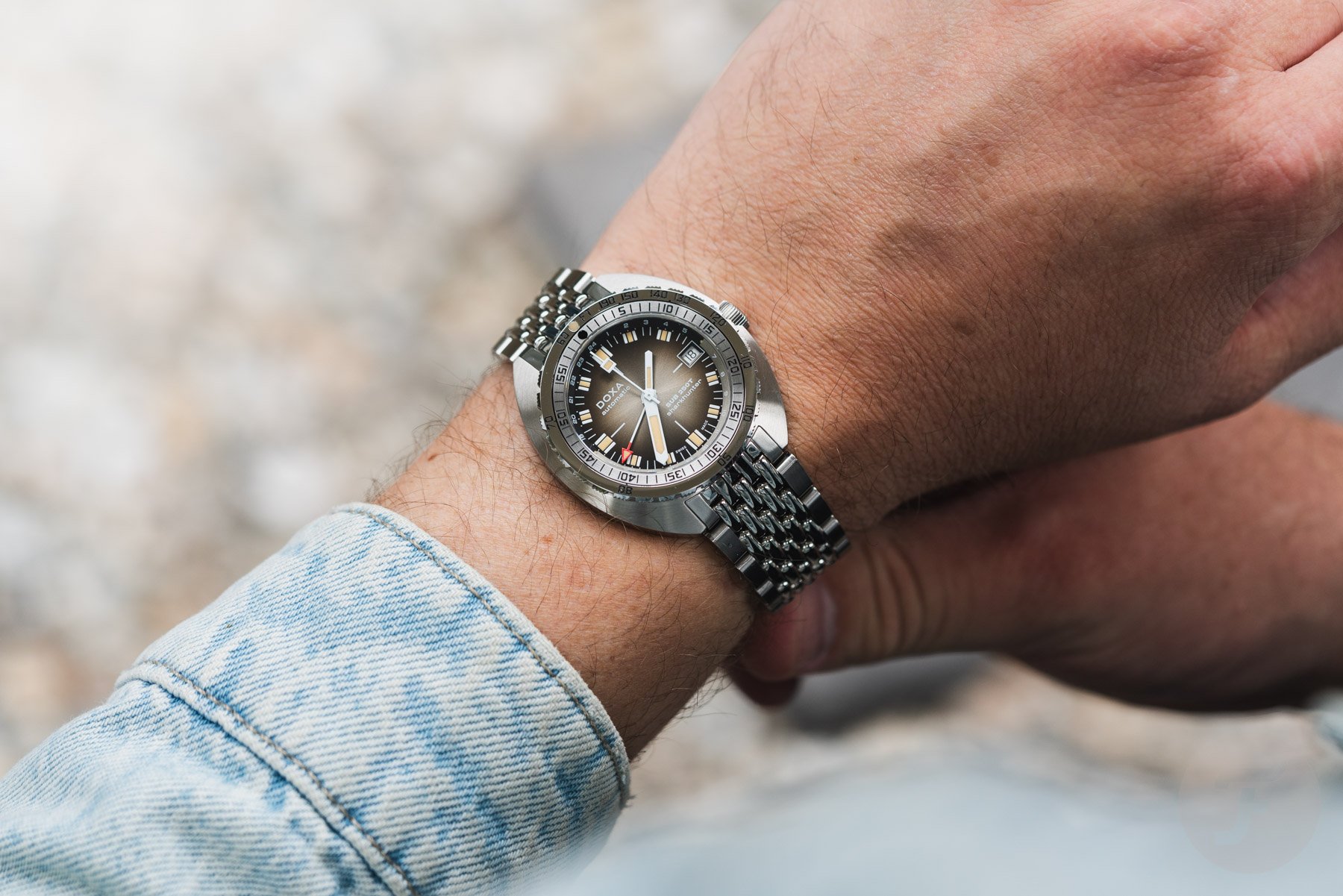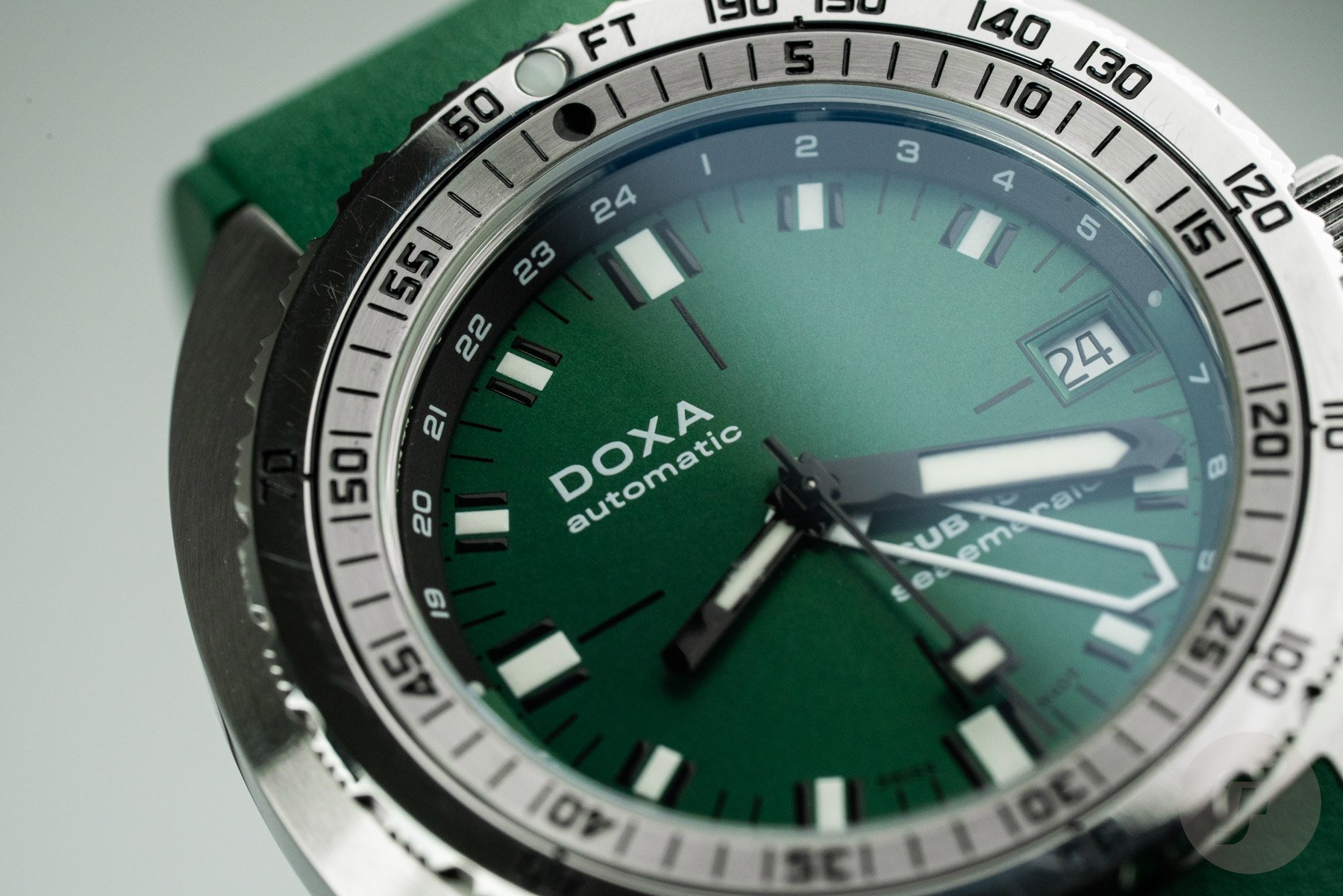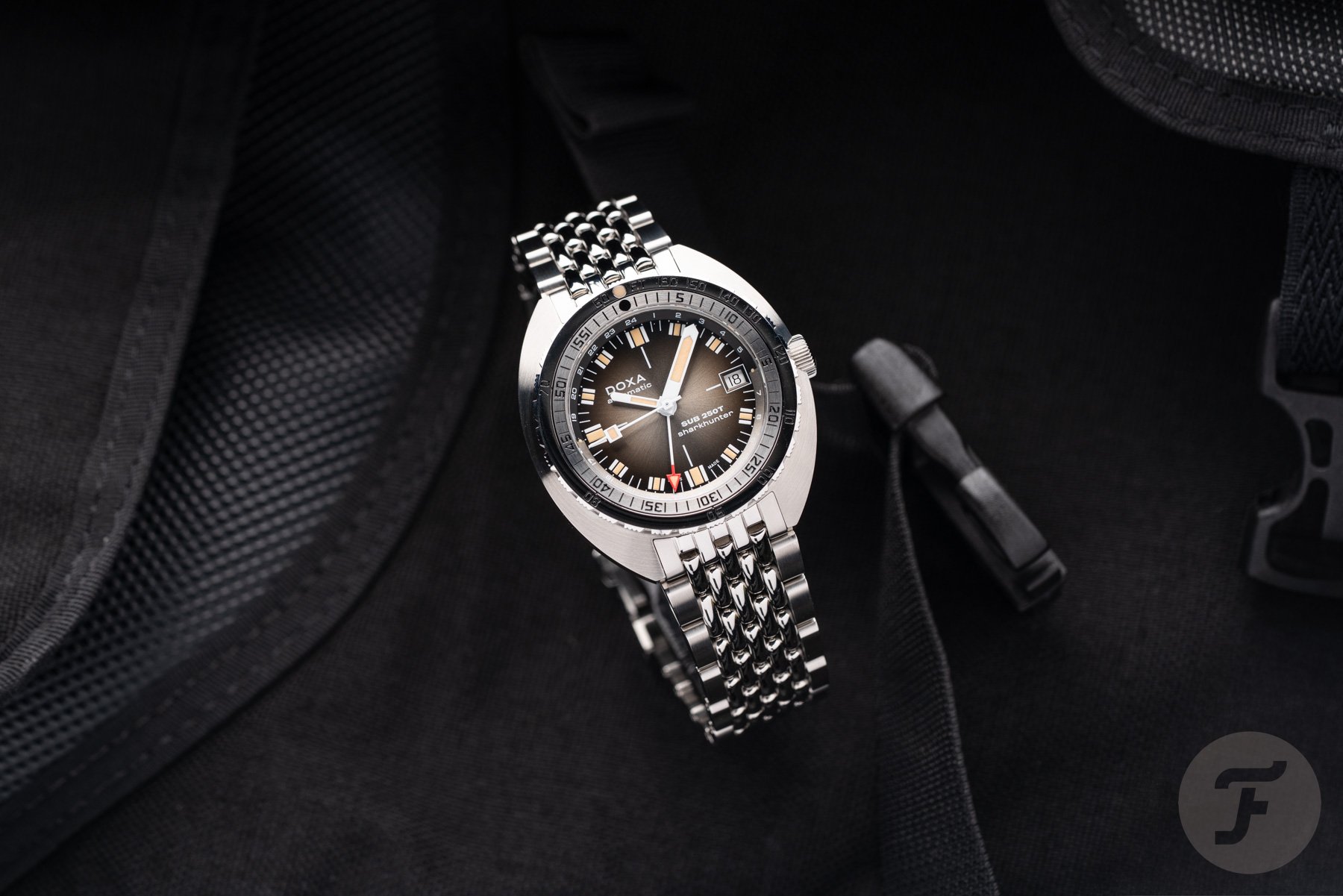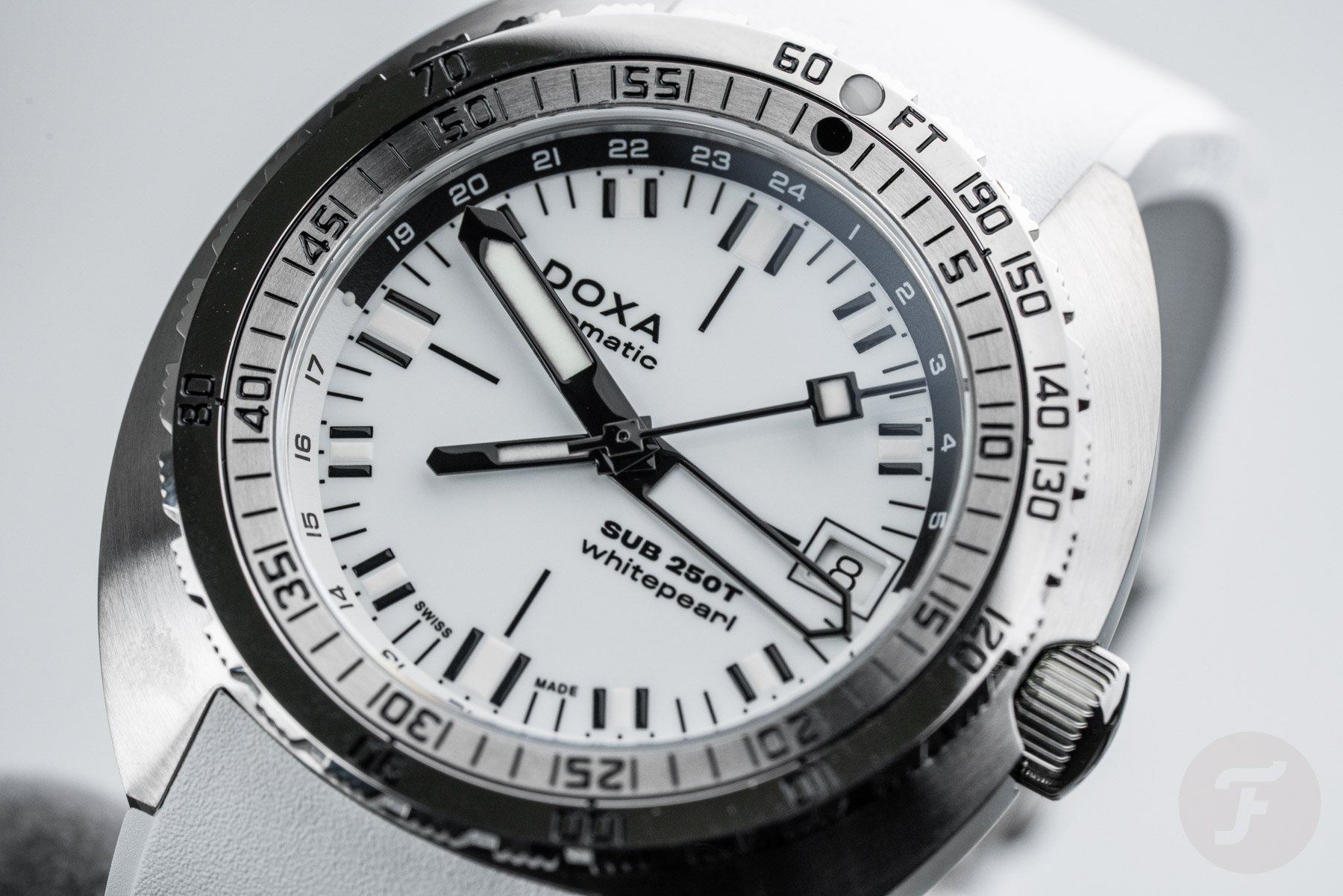Hands-On With The Sublime Doxa Sub 250T GMT
When Doxa dropped the new Sub 250T GMT a month ago, it was met with near-universal praise. Nine different dial options debuted, including the most famous Doxa colorways. We saw all of them in Geneva and had the opportunity to spend time with them at Fratello HQ. Today, I’ll review these pieces and address the GMT hand.
When my colleague Thomas reported on the initial release of the Sub 250T GMT, he mentioned that Doxa hadn’t offered a Sub GMT since 2006! Considering the popularity of this complication, it’s a surprise. By now, we know that Doxa has rectified this, but is this the watch everyone has waited for? In most ways, the answer is yes, especially considering the price. Let’s investigate.
The Doxa Sub 250T GMT
Before we get into the hands-on portion, let’s recap the basic specs of the Sub 250T GMT. While many of us, yours truly included, thought this watch was a Sub 200T with an extra hand, that’s incorrect. The 200T is a 39mm by 41.5mm watch with a thickness of 10.7mm. The new 250T is slightly larger, reading 40mm by 42.9mm and a thickness of 10.85mm. Admittedly, I was hard-pressed to tell the difference on the wrist — that’s a good thing!
Regarding the options, it’s best to remember that this is Doxa, and many colors exist. An orange Professional, a black Sharkhunter, an ombré black Vintage Sharkhunter, a silver Searambler, a dark blue Caribbean, a yellow Divingstar, a turquoise Aquamarine, a white Whitepearl, and a green Sea Emerald are all available on an FKM rubber strap or stainless steel beads of rice bracelet. Unlike the 200T, the GMT is unavailable in sunray and matte versions of each color.
Doxa-worthy specs
As a Doxa, there are minimum basic expectations for a new watch like the Sub 250T GMT. Substantial water resistance is required, and the watch is rated to 250 meters. A screw-down crown and solid stainless steel screw-in case back support this.
The brand’s traditional no-decompression dive bezel with a secondary 60-minute scale contains a luminous dot to aid dive timing. Super-LumiNova is also found on the hands and indices. Regarding the movement, Doxa states that the automatic is “Swiss” with a frequency of 28,800vph and 50 hours of power reserve. The 24-hour hand is adjustable, making this a caller-style GMT.
Seeing the Sub 250T GMT in person
We were greeted with a large case of watches when we walked into our appointment with Doxa in Geneva. All the Sub 250T GMT variants, on strap and bracelet, were there. With all the colors, it felt like a bowl of Skittles! Once the visual overload subsided, I dug into the pieces, began handling them, and put several on my wrist.
Handling a Doxa in person is easier now than before, but if you’ve never experienced one, I’ll do my best to explain. C-case watches aren’t overly popular, but a Doxa Sub bucks this trend. Picking one up for the first time provides a different feeling compared to a typical dive watch. A Doxa like the Sub 250T GMT feels solid, but light. The lugs are shorter than normal, and the bezel seems overly complicated, but precise. It feels like a tool or an instrument, consistent with the original intent.
Perfect dimensions for most wrists
With such a short 42.9mm lug-to-lug measurement, the Sub 250T works on a wide variety of wrist sizes. Due to its case shape, it looks wide. This helps it feel at home on larger wrists, too. The other all-important dimension is the 10.85mm of thickness. It’s not so thin as to feel invisible, but the diver is happy to slide comfortably under most shirt sleeves. Doxa built this watch for everyday use, and the footprint is proof in the pudding.
Bracelet or strap?
Choosing between a colorful 18mm FKM rubber strap and a beads of rice bracelet is challenging. Both are comfortable, but each has its demerits. The FKM is incredibly comfortable and flexible, but requires trimming to fit one’s wrist. The other negative is the large, bulky clasp. On the positive side, the clasp has a built-in microadjust. The bracelet gives off retro diver vibes and is comfortable enough, but I wish it were thinner and tapered toward the clasp. Overall, it’s hard to go wrong with either choice, but for €40 more, I’d opt for the bracelet. Besides, these watches have a reputation for being “strap monsters,” so enjoy experimenting with all sorts of options.
The controversial GMT hand
To create GMT functionality, Doxa chose to add a fourth hand to the watch. The 24-hour hand is mounted centrally and points to a bi-color 24-hour rehaut scale. This hand is a skeletonized copy of the minute hand on all color variants except for one (more on that momentarily). The 24-hour GMT hand is readable, although it’s more visible on some dials. My take is that Doxa wanted to offer the functionality, but chose to prioritize the original diving hands. Plus, the design recalls the 2006 750T, the last Doxa GMT. I think that’s fine because my experience with a GMT hand is that I don’t expect to be able to read it as quickly as a normal hour hand. Why? My brain isn’t trained to read a 24-hour dial, so checking the time of another zone will always require more checking. Long story short — the hollow, slightly invisible GMT hand is fine.
Caller versus traveler
Whenever we write an article about a GMT watch, the top comments relate to the caller versus traveler movement argument. Look, I quasi get the use case for a traveler GMT movement, but I’ve used both while traveling. I can’t think of an instance where one felt like an advantage over the other while taxiing to my gate. Besides, I’m a contrarian and actually like using the main hour hand to display home time. It’s what I always did with my 1675 and then used the bezel to align local time with the arrow hand. In fact, my top suggestion for the Sub 250T GMT is to provide an external rotating 24-hour bezel.
The exception piece — the Vintage Sharkhunter
For fun, truly, Doxa decided to stray from the path of traditional and newly added colors with the Vintage Sharkhunter. Instead of using a matte or sunray finish, this dial has an ombré effect with black, gray, and brown. The luminous material extends the vintage effect with an old radium hue on the hands, indices, and bezel pip. Another big change, which looks more traditional, is the red-tipped luminous arrow hand instead of a skeletonized design. It looks great and, yes, it does make us question whether it should be used on all of the color variants. In the end, I like the difference and would keep it specifically for the Vintage Sharkhunter. The hollow hand on the other colors looks more modern and works better with the design. At least that’s my opinion!
Colors, colors, which is the best?
Out of all the nine different dial colors available on the Sub 250T GMT, which do I like best? They’re all nice, and admittedly, I am still getting used to some of the more recent additions, such as green and aqua. The original Professional, Searambler, or Sharkhunter is hard to beat. If I had to choose, though, it would be between the Whitepearl and Vintage Sharkhunter. The white dial is crisp, and I like the simple black and white look. However, the smoky Vintage Sharkhunter is unique and appeals to my vintage side. Regardless, I think I’d be happy with either.

Final thoughts
The Sub 250T GMT is a great addition to the Doxa catalog. At €2,550 on the rubber strap or €2,590 on the bracelet, it’s also competitively priced considering the brand’s reputation for making a quality watch. Is the GMT complication worth €1,000 over the similarly-sized 200T? For many people, the answer will be yes because a 24-hour hand is helpful during work or travel. The fact that Doxa added the complication to the iconic Sub platform while maintaining a clean, legible look is also impressive. Making nine versions available in an attempt to please everyone is icing on the cake.
This is a partnership post. Read about our transparency here.

